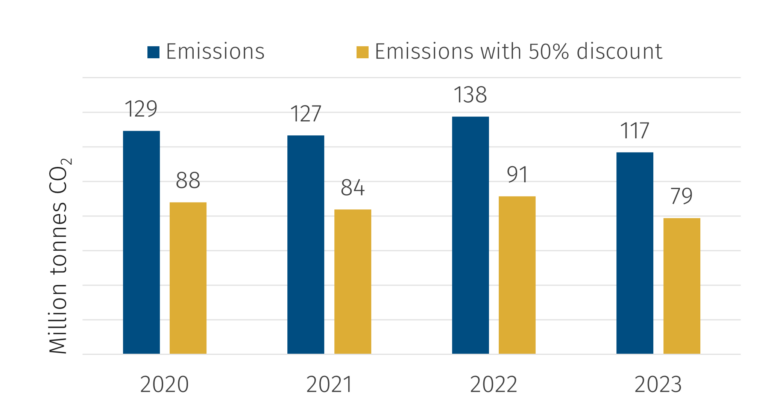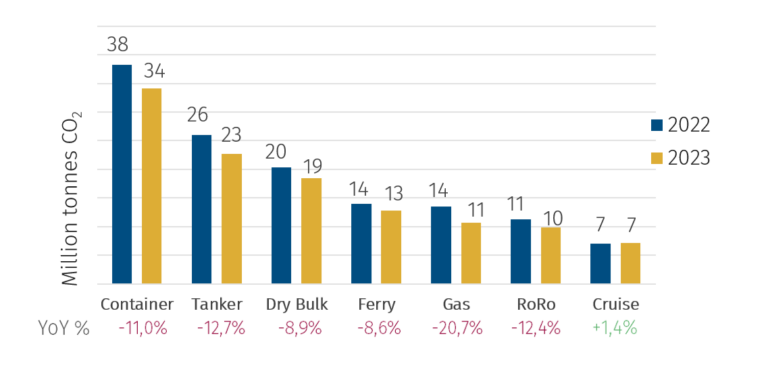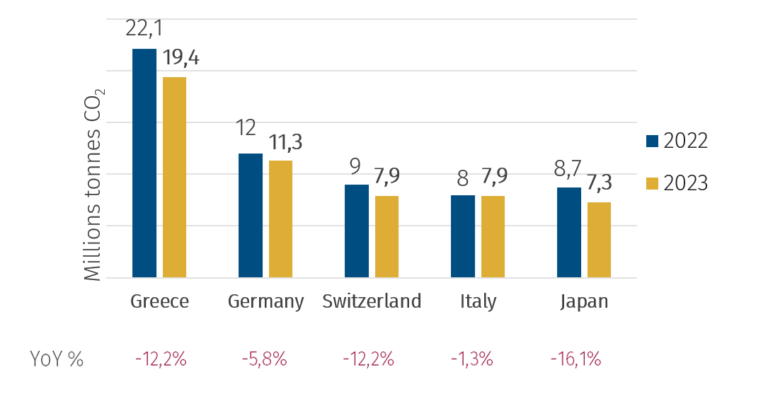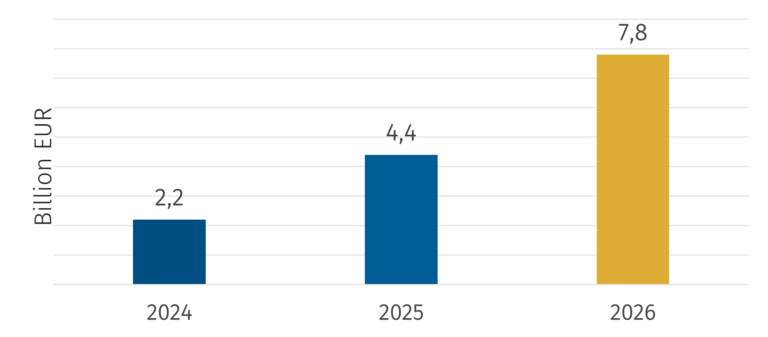According to the analysis of BRS Shipbrokers, the CO2 emissions from the EU MRV ships are dropped from 136.9 million tons in 2022 to 116,6 million in 2023
Emissions from European maritime transport decreased by 15.1% in 2023 compared to the previous year, according to preliminary data published this week by the European Maritime Safety Agency (ESMA). The agency collects and verifies ship’s emissions data from 2018, constantly monitoring the trend.
Since 2018, the European MRV directive has imposed more than 5,000 tonnes on ships, which call at the ports of the European Economic Area, to measure and verify their emissions. As of this year, these large ships have also been included in the European Emissions Trading System (EU ETS), a significant step in the fight against climate change.
The cost of the EU ETS for the shipping industry is estimated at €2.2 billion in 2024,
Analysis of BRS Shipbrokers
According to the analysis of BRS Shipbrokers, the CO2 emissions from the EU MRV ships are dropped from 136.9 million tons in 2022 to 116,6 million in 2023, marking a reduction of 15.1%. However, it is important to note that emissions of travel from a European Economic Area port to a foreign port, or vice versa, are covered by taxation at only 50%. Therefore, real ETS emissions fall to 78.9 million tonnes once the excluded volumes were removed, accounting for about 7% of the total 1,08 billion tonnes of all the ETS manufacturing and aviation sectors of 2023.
It must be said, however, that these preliminary data could evolve in the coming months, as ESMA regularly updates MRV files, adding missing ships and correcting any incorrect values.

source: 2023 EU MRV data analyzed and developed by BRS Shipbrokers
Decrease in emissions in 2023
The decrease in emissions in 2023 was widely predictable, as in 2022 there was significant demand for LNG and coal, and the world’s major economies were still emerging from the consequences of the Covid-19 pandemic. In 2023, gas carrier emissions recorded the biggest collapse, marking a -20.7% compared to 2022. The same applies to coal imports, which decreased significantly due to the collapse of European energy production from fossil fuels: utilities totaled 24% less than in 2022.
The categories of ships
The categories of ships with the highest emissions in 2023 were once again container ships, tankers and rain holders, although they also recorded a decrease compared to 2022. Oil tankers saw a 12.7% reduction in emissions and container ships fell by 11%, reflecting the decrease in energy demand and end products.

source: 2023 EU MRV data analyzed and developed by BRS Shipbrokers
Cruise ships
In contrast, cruise ships were the only category to report an increase in emissions, an increase of 1.4% compared to 2022. However, this increase must be contextualized considering that the cruise sector came from 2-3 years of difficulty caused by the restrictions due to the pandemic and which had led to a 40% drop in emissions compared to 2019
EU Member States
The owner’s country-source emissions division shows once again that Greece has recorded the highest amount of emissions among EU Member States, although it has seen a 12.2% decrease compared to 2022. Following we find Germany and Switzerland, also with a respective decline of 5.8% and 12.2%.

source: 2023 EU MRV data analyzed and developed by BRS Shipbrokers
€2.2 billion in 2024
The cost of the EU ETS for the shipping industry is estimated at €2.2 billion in 2024, assuming that the emissions remain in line with those of 2023 and considering only 40% of the total for gradual inclusion. This calculation is based on an average carbon quota price of 70 euros per ton. In 2026, with the expected carbon allowances at €100 per tonne and the full inclusion of 100% of emissions, the cost is expected to increase to €7.8 billion.

source: 2023 EU MRV data analyzed and developed by BRS Shipbrokers
First half of 2024
The forecasts for the first half of 2024 confirm that it is likely that the emissions from maritime transport covered by the EU ETS will continue to decline in the coming years, especially thanks to the entry into force of the FuelEU Maritime Regulation. This regulation will require a reduction in the carbon intensity of fuels used on board from 2025 with increasing five-year targets.
Using more sustainable fuels
Although total emissions will increase in 2024/2025, it is likely that they will be partially offset by the increased use of more sustainable fuels and also by the various exclusions of routes to small islands, overseas and public service regions. For this reason, we believe that the values of 2024 could remain in line with those of 2023, or with little upward change
EMSA Consolidated Annual Activity Report 2023
Sources : Shipping Itally +other sources




